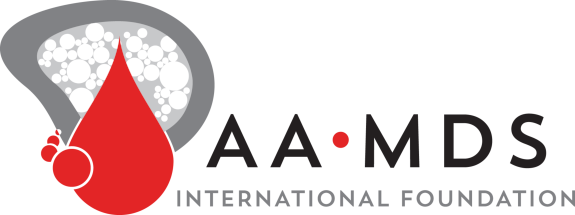Immunosuppressive drug therapy Immunosuppressive drug therapy: (i-myoo-no-suh-PREH-siv) Drugs that lower the body's immune response and allow the bone marrow stem cells to grow and make new blood cells. ATG (antithymocyte globulin) or ALG (antilymphocyte globulin) with cyclosporine are used to treat bone marrow failure in aplastic anemia. Immunosuppressive… lowers your body's immune response. This prevents your immune system from attacking your bone marrow bone marrow: The soft, spongy tissue inside most bones. Blood cells are formed in the bone marrow. , allowing bone marrow stem cells stem cells: Cells in the body that develop into other cells. There are two main sources of stem cells. Embryonic stem cells come from human embryos and are used in medical research. Adult stem cells in the body repair and maintain the organ or tissue in which they are found. Blood-forming (hemapoietic) stem… to grow, which raises blood counts.
For older patients with acquired aplastic anemia aplastic anemia: (ay-PLASS-tik uh-NEE_mee-uh) A rare and serious condition in which the bone marrow fails to make enough blood cells - red blood cells, white blood cells, and platelets. The term aplastic is a Greek word meaning not to form. Anemia is a condition that happens when red blood cell count is low. Most… , immunosuppressive drug therapy is the treatment of choice. It is also used for aplastic anemia patients who do not have a matched bone marrow donor. In some cases, it may be used for patients with MDS and PNH.
The three drugs used in immunosuppressive therapy include:
- Anti-Thymocyte Globulin (ATG)
- Cyclosporine Cyclosporine: Cyclosporine is used along with antithymocyte globulin (ATG), another immunosuppressant, for treating aplastic anemia and some other forms of bone marrow failure.
- Eltrombopag Eltrombopag: What are the possible side effects of eltrombopag (Promacta)? Get emergency medical help if you have any of these signs of an allergic reaction: hives; difficult breathing; swelling of your face, lips, tongue, or throat. Stop using eltrombopag and call your doctor at once if you have: …
Anti-Thymocyte Globulin (ATG)
ATG is approved in the U.S. to treat acquired aplastic anemia and to reduce the chance of organ rejection after a kidney or other organ transplant. It may also be used to treat MDS or reduce rejection after a bone marrow transplant bone marrow transplant: A bone marrow transplant (BMT) is also called a stem cell transplant (SCT) or hematopoietic stem cell transplant (HSCT).The procedure replaces unhealthy blood-forming stem cells with healthy ones and offers some patients the possibility of a cure. But for many patients, a BMT is not an option due… . In the U.S., it is also sold under the brand name Atgam®.
ATG works by killing specific cells in your immune system called T-lymphocytes — the cells that are attacking bone marrow stem cells in aplastic anemia. This allows an aplastic anemia patient’s bone marrow to rebuild its supply of bone marrow stem cells, causing blood counts to go up.
Usually, ATG is given by IV infusion into a vein for 8-12 hours a day, for 4 days. The schedule depends on your needs, the type of ATG used and doctor or hospital preference. No one schedule has been shown to be better than another.
How well does it work?
When used alone, ATG improves blood counts for aplastic anemia patients about half of the time. When used with cyclosporine, ATG improves blood counts in about 7 out of 10 cases. When a platelet platelet: The smallest type of blood cell. Platelets help the blood to clot and stop bleeding. Also called a thrombocyte. growth factor growth factor: A substance made by the body that stimulates the bone marrow to produce blood cells. Some growth factors are man-made in the laboratory and used for treating low blood counts. These include red blood cell growth factors called erythropoietin (EPO) and darbepoetin, and white blood cell growth… called eltrombopag (Promacta®) is also given, more than 7 in 10 people see improved blood counts.
If it works, ATG usually stops the need for blood transfusions blood transfusions: A blood transfusion is a safe and common procedure. Most people who have a bone marrow failure disease like aplastic anemia, MDS or PNH will receive at least one blood transfusion. When you receive a blood transfusion, parts of blood from a donor are put into your bloodstream. This can help some… within 3 months. Full success can take at least 9 months. Some patients may respond initially, but may later relapse and need another treatment.
What are common side effects?
When receiving the treatment, some common side effects are:
- Chills
- Fever
- Hives
- Nausea
- Vomiting
- Diarrhea
- Dizziness
- Headache
These side effects usually go away after treatment.
Horse vs. Rabbit ATG
ATG is created injecting human white blood cells (T cells) into a horse or a rabbit, and extracting the antibodies produced. A recent study conducted by the National Institutes of Health (NIH) found that horse-derived ATG provided a better overall response rate in aplastic anemia patients. In other words, patients who took horse ATG had increased blood counts, and the counts stayed up longer when compared to patients given rabbit ATG. Learn more about this study
Cyclosporine
Cyclosporine prevents T-lymphocytes, a type of white blood cell white blood cell: Cells in the body that fight disease and infection by attacking and killing germs. There are several types of white blood cells including neutrophils, eosinophils, basophils, lymphocytes and monocytes. Each type of cell fights a different kind of germ. Also called WBC, leukocyte. , from becoming active. Once the T-lymphocytes are turned off by the cyclosporine, they stop attacking stem cells in the bone marrow. In aplastic anemia patients, this allows bone marrow stem cells to grow back and start making blood cells again.
Cyclosporine is typically used in combination with ATG to treat acquired aplastic anemia. It is also used to prevent rejection after an organ transplant and to reduce immune response after a bone marrow transplant.
Cyclosporine comes in liquid and pill forms. The first dose is based on how much you weigh. Later doses depend on the amount of cyclosporine in your blood. Too little cyclosporine will not work; too much will cause side effects. If you are responding well to cyclosporine, your doctor may decrease your dose over time.
How well does it work?
When used alone, cyclosporine is less effective than ATG. When used with ATG, cyclosporine improves blood counts in about 7 out of 10 cases of acquired aplastic anemia.
What are common side effects?
Some common side effects include:
- Tremors or shaking
- Nausea
- Diarrhea
- High blood pressure
- Kidney problems
- Loss of magnesium or potassium
- Liver inflammation
- Increased hair growth
- Gum swelling and pain
These problems can usually be fixed by taking medicine to lower your blood pressure and by replacing the lost magnesium or potassium.
Eltrombopag
Eltrombopag (Promacta) is used to increase the number of platelets (cells that help blood clot blood clot: A mass of blood that forms when platelets stick together. Harmful blood clots are more likely to happen in PNH. The term thrombus describes a blood clot that develops and attaches to a blood vessel. The term embolus describes a blood clot or other foreign matter that gets into the bloodstream and… ) and to decrease the risk of bleeding. It is a man-made platelet growth factor that signals your bone marrow to make more platelets. Eltrombopag was approved by the U.S. Food and Drug Administration in 2014 to treat refractory refractory: Not responsive to treatment or cure. For example, refractory anemia is a low red blood cell count that doesn't respond to standard treatments. aplastic anemia. In 2018, Eltrombopag was FDA approved as a first line therapy to treat aplastic anemia. It comes as a tablet and as a powder for oral suspension (liquid) to take by mouth.
What are the possible side effects of eltrombopag (Promacta)?
Get emergency medical help if you have any of these signs of an allergic reaction: hives; difficult breathing; swelling of your face, lips, tongue, or throat.
Stop using eltrombopag and call your doctor at once if you have:
- pain or burning when you urinate;
- fever, chills, body aches, flu symptoms, unusual weakness or tired feeling;
- nausea, upper stomach pain, itching, loss of appetite;
- dark urine, clay-colored stools;
- jaundice jaundice: A yellow coloring to the eyes and/or skin due to an increased level of bilirubin, which is a breakdown product of hemoglobin. (yellowing of the skin or eyes);
- pain, swelling, warmth, or redness in one or both legs


